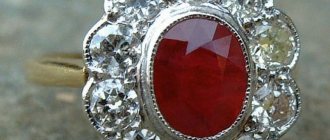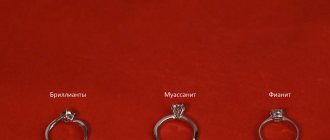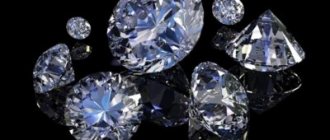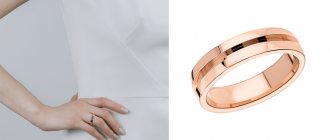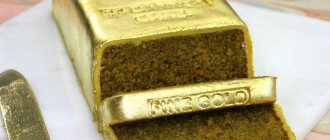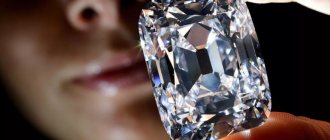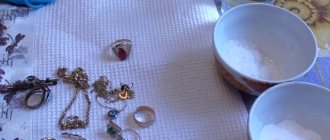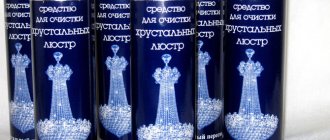BIG DIFFERENCE: PROCESSED OR ARTIFICIAL
Processed stones stand apart from real and fake gems.
It is difficult to call processed minerals “artificial”: they are almost identical to real ones.
| PROCESSED |
|
| ARTIFICIAL |
|
Modern technologies
High-quality artificial nanocrystals are an excellent development of scientists from Russia, which makes it possible to grow synthesized stones of the highest quality in a laboratory environment. The characteristics and properties of such a gem repeat all the mineralogical characteristics of natural topaz.
Only a specialist can determine whether the stone in front of him is real or not. The presented specimens have the same high hardness as topaz, and they have a uniform color. These minerals are simply ideal, so it is impossible to give an expert assessment simply after inspection.
Artificial topazes are produced using the hydrothermal method. To do this, you need to take certain components, start melting and a chemical reaction between them. The result of this work is an almost perfect stone.
There is another method of “noble counterfeiting” of natural precious stones. The raw material for making “counterfeits” is quartz. Its price is significantly lower than topaz and such production is considered economically profitable. It is important that when making a purchase, the seller warns that this is only a replica of natural topaz and that the price is not unreasonably inflated.
VARIETY OF TOPAZES AND FINISHES
Blue
The blue shade is the most recognizable: most people associate topaz with it. Shades range from pale to deep blue, or “London”.
Synthetic topaz is usually also blue. Rare natural cornflower blue minerals are mined in Brazil.
We recommend: CHIC, SHINE, BEAUTY | How to grow NANO-SAPHIRE
Champagne
Truly regal and luxurious - a champagne-colored mineral. Such stones are often counterfeited - after all, the shade is rarely found in nature and costs hundreds of dollars.
Imperial
Imperial are called yellow, orange or red topazes. Despite their beauty, these stones are not in demand.
The rarest imperials are pink minerals. By the way, a natural stone is unmistakably distinguished by its pink hue: like colorless topaz, such topaz cannot be faked.
Rauchtopaz
“Smoky” (translated from German) topaz is nothing more than a type of quartz. Sellers may “forget” to explain this difference. The gem is a beautiful and deep brown shade, but should be sold as quartz.
How to distinguish topaz from a fake
Before you go shopping for expensive jewelry with the desired topaz, you definitely need to understand how to distinguish it from a fake. Jewelers today create masterful copies of natural gems, earning decent sums from it.
First, let's figure out how to distinguish topaz from aquamarine - such replacements also cannot be called a rarity in the jewelry world.
It is important to remember that aquamarine will never give such rich color and shine as topaz. To determine the authenticity of the proposed specimen, specialists have a refractometer with them; this device will accurately show which mineral the seller is offering to purchase from him. It is important to remember that aquamarine is lighter than topaz and this can be felt by a person even without special equipment.
There is another rather insidious counterfeit of an expensive gem - this is the artificial mineral cubic zirconia. Such a specimen is quite close in appearance to an expensive gem. Cubic zirconia can be of different colors:
- yellow;
- orange;
- blue.
To give a final conclusion about the quality of the stone, it is necessary to conduct a laboratory analysis of the crystal lattice of the presented sample. You can distinguish topaz from cubic zirconia yourself. The budget analogue does not have the effect of pleochroism - it is simply not able to change the hue when the lighting or viewing angle changes.
You can also see many glass and quartz counterfeits of topaz on the market. The cost of such stones is very low, and the market price of the product is high, because it is presented as a piece of jewelry.
There are a couple of features that will prevent you from confusing an expensive topaz with a cheap fake:
- quartz and glass have a rough surface - real stone has smooth edges;
- the mineral must have small defects in its structure, visible inclusions - a fake has an ideal appearance, where there is no room for imperfection;
- In most cases, an expensive stone is framed in gold or platinum; if on the counter you see a lot of jewelry with topaz in silver, this is most likely a batch of cheap fakes;
- glass will always show itself to be too rich and deep in color, which simply does not exist in nature;
- There is another option on how to distinguish a fake - hold the stone in your hand, if it heats up quickly, they are trying to fool you, because the topaz will be cool for a long time;
- all too shiny stones are fake gems; the mineral has a deep, muted shine;
- One of the easiest ways to identify a fake is the electrification of the surface; if you rub the surface with a woolen cloth, and small particles are not attracted to the stone, this is a fake.
If you have carried out the most well-known authentication tests, but doubts remain, ask the seller for documents for the goods. Real stones are inspected by professional appraisers. If there are no documents or the seller simply refuses to provide them, you can refuse the possible purchase. Such behavior indirectly confirms that the product on the counter is fake.
Perfect fake
We have already figured out that in a laboratory it is possible to create an ideal copy of a real stone. It’s worth remembering the name of such a product – nanotopazes. It is also important to take into account their main characteristics:
- hardness – hydrothermal stones are grown so that the hardness mark tends, like that of natural stones, to 8 on the Mohs scale;
- density - it will be slightly less than that of real gems, artificial specimens are lighter, you can easily feel it;
- absence of defects - small inclusions and cracks can be seen in the structure of a natural mineral, but all this is unusual for an artificial analogue;
- ideal shape and cut - in the process of growing nanotopazes, they are given the desired shape, and after cutting it becomes simply ideal, there can be no errors here;
- perfect color - nanotopazes are 1-2 shades brighter than natural stones, some even call this an advantage of such a product.
The chemistry of cubic zirconia is the main difference from diamond
Cubic zirconia is zirconium dioxide with various stabilizers, diamond is one of the modifications of pure carbon. It is unrealistic to determine the formula of a substance at home, but knowing some of their properties, you can distinguish one mineral from another. A diamond, with the same volume, weighs less than its artificial counterpart, since its density is lower. If a little oil gets on the surface of the diamond, it will not spread. This feature is also determined by the chemical properties of the mineral.
Hardness
Diamond is harder than cubic zirconia, it cuts glass, and zirconium leaves only a superficial scratch. It is almost impossible to damage a diamond, while tiny marks may appear on cubic zirconia. To test its hardness, you can rub the stone with sand or try to scratch it with a piece of glass.
Processing method
In the jewelry industry, each precious or semi-precious stone is usually processed according to a specific technique. A diamond always has 57 edges that are sharp and never break, while synthetic crystals have fewer edges that are rounded and if you look at the light, you will notice that the light is refracted twice on the surface of the piece. To determine these properties, you need to be very careful or have a lot of experience. Professionals use a magnifying glass with a powerful lens or a microscope.
Who is cubic zirconia recommended for?
It is believed that the crystal is especially good for creative people and scientists. A person who works with a lot of information will find a pendant or ring with this stone useful.
The magical properties of cubic zirconium help strengthen the overall tone of the body, activate vitality and perform a very large amount of work in a short time. Therefore, it is suitable for journalists and travelers who want to visit more countries.
The value of cubic zirconia for a person in the magical sphere is quite great, as it brings good luck and joy. Even after purchasing it, a person experiences great satisfaction, because a tiny stone is indistinguishable from elite precious stones. A person’s subconscious is filled with self-confidence and new high goals.
Synthetic analogue diamonds are not suitable for people with strong leadership qualities.
The stone of loneliness is sometimes called cubic zirconia, because it is always in the shadow of precious stones and acts as their imitation or fake. Therefore, some esotericists claim that artificial stone is two-faced and false, while others consider this opinion to be erroneous. They are sure that this attitude towards this stone appeared only thanks to people who were deceived and made huge profits.
Origin of stones
The cubic zirconia stone gained its popularity in 1980, when Swarovski began producing this stone and using it as jewelry parts. Cubic zirconia is an artificial crystal. It is invented by crystallization. Cubic zirconia is transparent, making it visually identical to diamond. Modern production of cubic zirconia presents them in various colors and shapes.
White topaz is a natural stone that is mined naturally. White topaz comes from silicate topaz. This stone is available in different colors, sizes and shapes.
What group of stones does topaz belong to? Physical properties
From a molecular point of view, topaz is a crystallized silicate, consisting of 48-62% aluminum oxide. Its natural state is an impressive block of prismatic or bipyramidal shape. Taking into account the rock on which the stones are formed, nuggets reach a specific gravity of up to 80 kg each, although much larger examples have been recorded in history.
Interesting fact: The largest topaz was found in 1984 in the Brazilian state of Minas Gerais. The piece of rock where it was located reached almost 6 tons, and the crystal itself weighed more than 131 kg. Unfortunately, the massiveness did not allow it to maintain its size; the gem instantly crumbled at the time of extraction, and the largest fragment after cutting began to weigh 31,000 carats (6.2 kg). Its owner is now the Spanish mining company whose workers discovered this geological miracle.
Other physical properties of topaz:
- Density – up to 3.57 grams per cubic centimeter;
- Mohs hardness – 8;
- Refractive index – around 1.638;
- Natural impurities - iron, chromium, vanadium, titanium.
The main thing to remember is that topaz is very fragile, despite its hardness and cleavage density close to diamond.
It can easily be damaged by simply throwing it on the floor - the transparent surface will immediately become covered with a fine network of cracks. The same applies to direct contact with diamonds or corundums - sharp edges will leave quite deep grooves without any effort.
Caring for products with cubic zirconia
To maintain their original condition, cubic zirconia requires regular maintenance:
- Cleaning stones. It is recommended to clean cubic zirconia with a small brush using a soap solution and warm water. It is important to note that when cleaning and other labor tasks, as well as procedures for applying makeup and other tasks, jewelry with cubic zirconia must be removed to avoid tarnishing of the crystal.
- Cleaning the frame. Cubic zirconias are used to decorate gold, silver and platinum jewelry. The frames listed are rarely subject to scratches or discoloration. Gold, silver and platinum jewelry with cubic zirconia can be cleaned using a special jewelry cleaner. Often gold and silver jewelry is coated with protective metals. In this case, the product must be cleaned using a brush and soap solution, and after the procedure, the product must be wiped dry.
This is interesting! How to choose the right amber jewelry
What stones does topaz go with?
The opinion that sky blue crystals are self-sufficient and incompatible with other gems has long been refuted by the world's leading designers. It is allowed to combine pebbles with each other, the main thing is to maintain harmony of shades and avoid excessive contrast. For topaz, the best companions in a jewelry composition are:
- Diamond;
- cubic zirconia;
- Amethyst;
- Turquoise;
- Aquamarine;
- Chrysolite;
- Pearl;
- Zircon;
- Pomegranate;
- Ruby.
Topazes are incompatible with minerals of dark shades - agate, black pearl, sultanite, rauchtopaz, onyx, jasper and similar crystals. You should be careful when wearing jewelry with emeralds at the same time - they have a completely different palette harmony, and green color can hardly be called light.
Creation and application process
The technology for producing this precious stone, created by Soviet physicists, is very labor-intensive and consists of several stages:
- Raw materials - powdered zirconium oxide is placed in a special container.
- Under the influence of the energy of a high-frequency generator, the internal part melts.
- Water circulates in tubes that regulate the temperature of the outer layer, which should not rise above room temperature. The outer layer should be hard and cold.
- Then the molten inner layer cools to room temperature, the core solidifies, and cylinders measuring 2*2 cm emerge from it. The crystal growth cycle is very short, in one hour the material grows by an average of 9 mm.
Today, Soviet technology for growing cubic zirconia is too expensive for most jewelry companies, which leads to simplification of production. However, stones created by this simplified method cannot be called real cubic zirconia.
Popular jewelry with topaz
The Karatov online store catalog offers a huge selection of products at affordable prices:
- Earrings;
- Rings;
- Bracelets;
- Pendants and pendants;
- Brooches;
- Necklace;
- Pins;
- Crosses.
In addition, each customer gets access to a bonus system - pay for subsequent orders with accumulated points up to 15% of the order amount.
Where can you find an amethyst stone?
Active mining of amethysts is carried out in deposits located in Brazil and North America. In Russia, the mineral is found in the Subpolar Urals. Stones are also mined in Germany, Armenia, and on the islands of Madagascar and Ceylon.
Interesting materials:
Why is Morse code needed now? What is a wide-angle camera for? Why is a forensic medical examination needed? Why is dark matter needed? What is the KingRoot application for? Why do you need to overclock your video card? Why are excise stamps needed? Why are eggs needed in baking? What are roots for? What are cooling curves for?
What affects the price of cubic zirconia
We begin to bend our fingers, calculating what the price of the stone will be:
- Production costs (employee wages, energy costs, equipment and raw materials costs). You can continue this list yourself.
- There are standard shades of cubic zirconia and special ones, the latter include: “blue topaz”, “ruby”, “sapphire”, “emerald”, they will cost twice as much - the technology of their production plays a role.
- The more complex the cut, the more valuable the stone.
- In jewelry, size matters, crystals up to 3 carats cost about the same, larger stones are more expensive to produce and increase the cost of the stone.
- Important: the carat (weight of the stone) does not affect its size.
How to distinguish diamond and cubic zirconia at home
There are several ways to distinguish a diamond from a cubic zirconia using simple home methods, if at least one works, you will see not a noble diamond, but a good cubic zirconia.
- A drop of lubricant on the surface will leave the diamond in place, and the artificial crystal will dissolve into the droplets.
- Lubricate it with oil and try to attach it to the glass - only the diamond will stick.
- Breathe on the sample - only cubic zirconia will fade;
- Count the facets - a diamond has at least 57 of them.
Who is topaz suitable for according to their zodiac sign?
There are several people in the horoscope who are strongly advised to wear sky blue stones:
- Aries - to balance internal impulsiveness, especially when life is not at its best, and there is a risk of lashing out at others.
- Gemini - emphasize the rare intellectual nature, and also calmly combine accessories of different colors with each other.
- Leo - it is better for them to choose rings in order to always show loved ones a symbol of their own exclusivity.
- Libra is another intellectual of the zodiac cycle, for whom talismans that stimulate mental activity at any time of the day are vital.
- Scorpio - a pendant, pendant, or any jewelry that hangs around the neck, closer to the heart, is suitable. This is 100% your patron stone.
It is not recommended for Taurus and Capricorn to wear items with topaz - for them it is better to choose green-colored gems that correspond to the energy of both signs.
Cubic zirconia - healing properties
Cubic zirconia has a dual nature: a natural base and a “diamond” structure, but the creation process is instantaneous, by nature’s standards. Its healing and magical properties are controversial.
Adherents of lithotherapeutic stones believe that the stone is considered a healing organism; it emits the energy accumulated by the primary source substance plus that received during creation.
Contemplating the stone improves your mood and gives you strength to recover from a nervous shock, serious illness or surgery.

